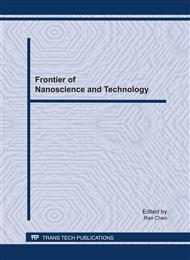[1]
F. Baletto, R.Ferrando, Structural properties of nanoclusters: Energetic, thermodynamic, and kinetic effects, J. Rev Mod Phys. 77(2005) 371-423.
DOI: 10.1103/revmodphys.77.371
Google Scholar
[2]
G. Ertl, H. J. Freund, Catalysis and surface science, J. Phys Today. 1(1999) 32-38.
Google Scholar
[3]
C. R. Henry, Surface studies of supported model catalysts, J. Surf Sci Rep. 31(1998) 231-325.
Google Scholar
[4]
H. Gleiter, Nanocrystalline materials, J. Progr Matter Sci. 33(1989) 223-229.
Google Scholar
[5]
S. Valkealahti, M. Manninen, Molecular dynamics simulation of crystallization of liquid copper clusters, J. Phys: Condens Matter. 9(1997) 4041-4050.
DOI: 10.1088/0953-8984/9/20/004
Google Scholar
[6]
R. Liu, J. Y.Li, K. J. Dong, Formation and evolution properties of clusters in a large liquid metal system during rapid cooling processes, J. Mater. Sci. and Engineer B. 94(2002) 141-148.
Google Scholar
[7]
S.L. Gafner, L.V. Redel, Y.Y. Gafner, Simulation of the processes of structuring of copper nanoclusters in terms of the tight-binding potential, J. Journal of Experimental and Theoertical Physics. 108(2009)784-799.
DOI: 10.1134/s1063776109050070
Google Scholar
[8]
L. Zhang, S. N. Xu, C. B. Zhang, Y. Qi, Molecular dynamics investigations of structural changes accompanying with freezing a molten Cu135 cluster on cooling, J. Computational Materials Science. 47(2009) 162-167.
DOI: 10.1016/j.commatsci.2009.07.002
Google Scholar
[9]
H. S. Nam, N. M. Hwang, B. D. Yu, J. K.Yoon, Formation of an icosahedral structure during the freezing of gold nanoclusters surface-induced mechanism, J. Phys Rev Lett. 89(2002) 275502-1-4.
DOI: 10.1103/physrevlett.89.275502
Google Scholar
[10]
S. N. Xu, L. Zhang, Y. Qi, C. B. Zhang, Molecular-dynamics simulation of structure changes of a molten Cu555 cluster during freezing, Physica B. 405(2010) 632-637
DOI: 10.1016/j.physb.2009.09.078
Google Scholar
[11]
F. F. Chen, H. F. Zhang, F. X. Qin, Z. Q. Hu, Molecular dynamics study of atomic transport properties in rapidly cooling liquid copper, J. J Chem Phys. 120(2004)1826-1831
DOI: 10.1063/1.1636452
Google Scholar
[12]
R. S. Liu, K. J. Dong, Z. A. Tian, H. R. Liu, Formation and magic number characteristics of clusters formed during solidification processes, J. Phys: Condens Matter. 19(2007)196103
DOI: 10.1088/0953-8984/19/19/196103
Google Scholar
[13]
L. Zhang, H. X. Sun, Molecular dynamics study of structural changes in freezing Cu(N=51-56) clusters, J. Solid State Communications. 149(2009) 1722-1725
DOI: 10.1016/j.ssc.2009.06.011
Google Scholar
[14]
Z. A. Tian, R. S. Liu, P. Peng, Freezing structures of free silver nanodroplets: A molecular dynamics simulation study, J. Phys Lett A. 373(2009)1667-1671
DOI: 10.1016/j.physleta.2009.02.041
Google Scholar
[15]
Y. Chen, J. X. Zhang, L. Wang, Simulation studies on structural evolution of gold clusters during solidification, J. Mater Lett. 59(2005)676-681
DOI: 10.1016/j.matlet.2004.11.012
Google Scholar
[16]
Y. Y. Gafner, S. L.Gafner, P. Entel, Formation of an icosahedral structure during crystallization of nickel nanoclusters, J. Physics of the Solid State. 46(2004)1327-1330.
DOI: 10.1134/1.1778460
Google Scholar
[17]
S. L. Gafner, S. V. Kosterin, Y. Y. Gafner, Formation of structure modifications in copper nanoclusters, J. Physics of the Solid State. 49(2007)1558-1562.
DOI: 10.1134/s1063783407080264
Google Scholar
[18]
J. Mei, J. W. Davenport, G. W. Fernando, Analytic embedded-atom potentials for fcc metalsa: Application to liquid and solid copper, J. Phys Rev B. 43(1991)4653-4658.
DOI: 10.1103/physrevb.43.4653
Google Scholar
[19]
J. D. Danaand, H. C.Andersen, Molecular dynamics study of melting and freezing of small Lennard-Jones clusters, J. J Phys Chem. 91(1987)4950-4963
DOI: 10.1021/j100303a014
Google Scholar
[20]
H. Jonsson, H. C. Andersen, Icosahedral ordering in the Lennard-Jones liquid and glass, J. Phys Rev lett. 60(1988)2295-2298.
DOI: 10.1103/physrevlett.60.2295
Google Scholar
[21]
C. L. Kuo, P. Clancy, Melting and Freezing Characteristics and Structural Properties of Supported and Unsupported Gold Nanoclusters, J. Phys Chem B. 109(2005)13743-13754.
DOI: 10.1021/jp0518862
Google Scholar
[22]
Q. N. Fan, W. Li, L. Zhang, Molecular dynamics study of relaxation and local structure changes in rapidly quenched molten Cu57 cluster, J. Acta Physics Sinica. 59(2010)2428-2433.
DOI: 10.7498/aps.59.2428
Google Scholar


